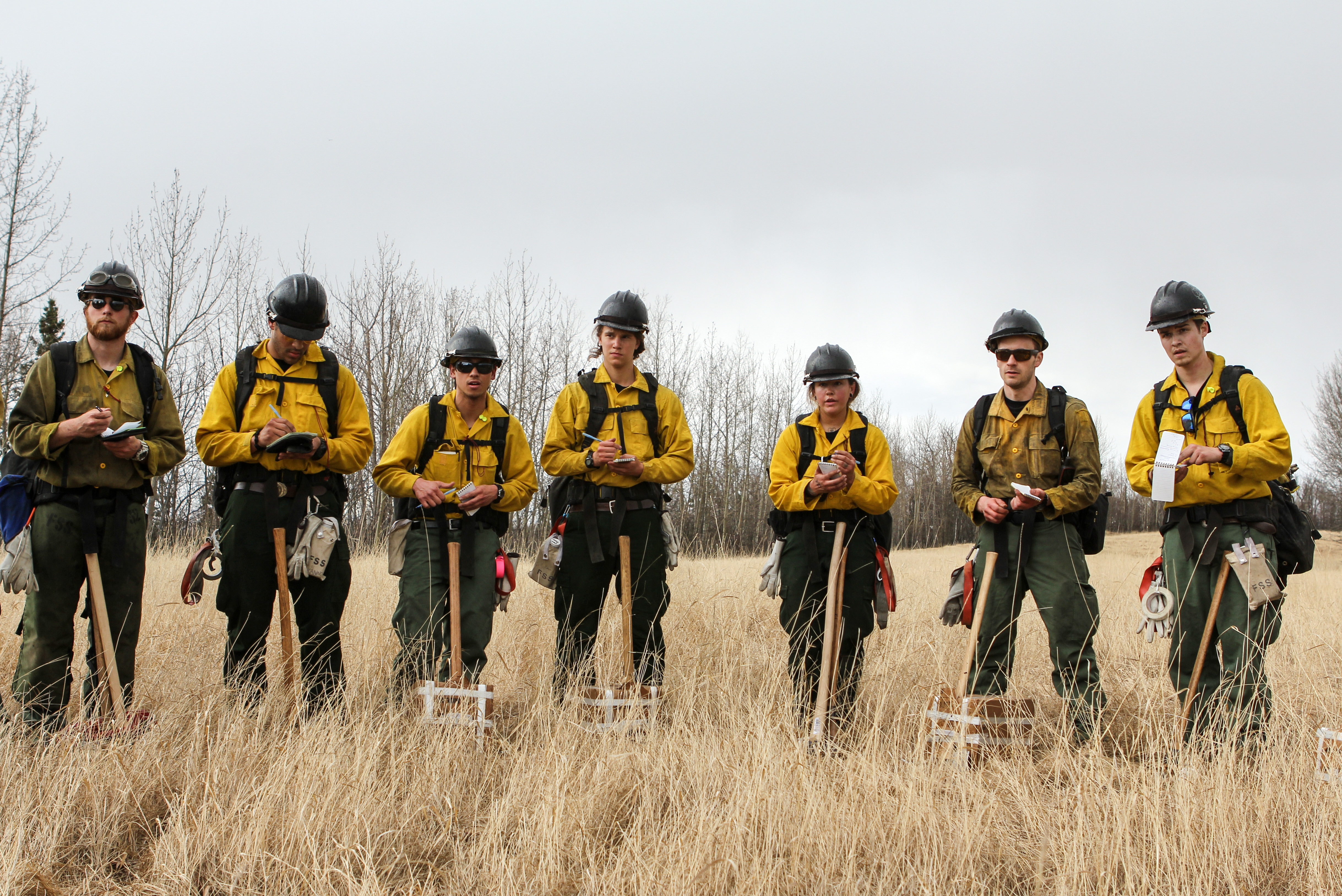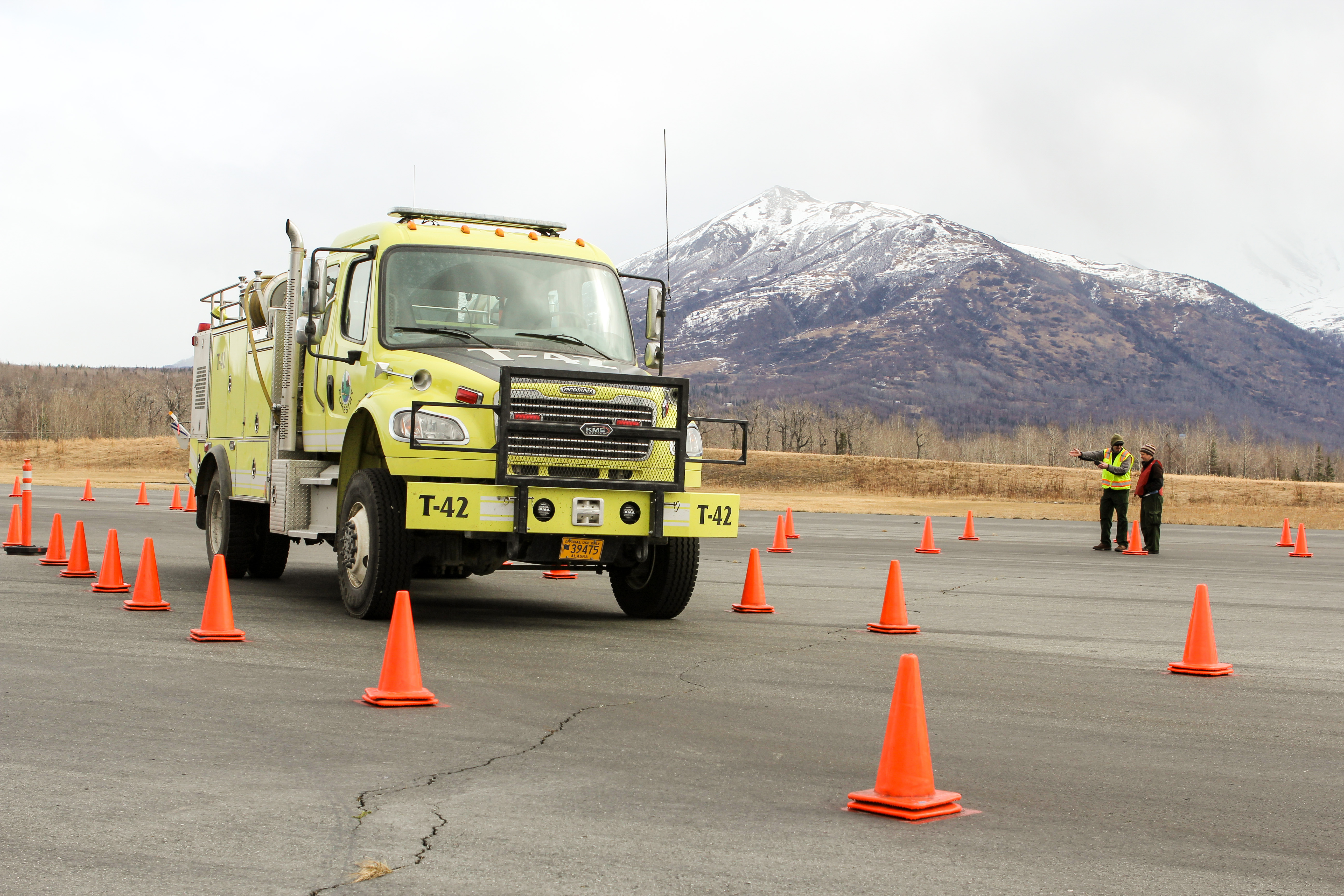
Thursday, April 29, 2018, near Palmer. (Photo by Casey Grove/Alaska Public Media)
It’s the start of wildland fire season in Alaska, and to make sure they’re ready for it, firefighters have been testing their proficiency at operating equipment, as well as their mental and physical fortitude.
At the same time, fire officials are watching out for the hot, dry and windy weather that elevates fire danger. They say it’s difficult to know what to expect heading into this fire season, and for now the firefighters are doing everything they can to be ready.
Two groups performing those preparations recently — the Pioneer Peak Hotshot Crew and Gannett Glacier Fire Crew — are among the best in the state. But even they have mandatory training every year.
Near the Matanuska Experiment Farm on Thursday, a line of about a dozen firefighters in yellow shirts and hardhats followed their chainsaw-wielding teammates up a hill, cutting a swath through the forest alongside an imaginary wildfire.
Pioneer Peak crew superintendent Kris Baumgartner explained.
“So right off the edge of it, right in front of it, we’re gonna remove those fuels with the chainsaws, and then dig a trail up,” Baumgartner said. “And the fire burns to the edge of the fire line, that dirt. And dirt doesn’t burn, and ideally that holds your fire.”
This is the kind of boots-on-the-ground work it takes to contain potentially massive fires. The goal is to protect people and homes, but it can be dangerous. That’s where the training comes in, Baumgartner said.
“Yeah, in these field days, they don’t know what’s coming, and so I’m trying to test them, and make sure everything we’ve taught ’em in the last two weeks is setting in,” Baumgartner said. “And so if we do end up making any mistakes, we hope that it’s on days like today, field days, simulation days, and not in another week when we become available for fires.”
The Gannett Glacier crew was nearby, marching through a grassy field. They had their own imaginary fire to fight. In a real fire situation, there would be a more-obvious, towering column of smoke, but this one was just marked with pink flagging. The crew stood in a circle for a quick briefing. Some took the opportunity to take a swig of water from their canteens.
The men, and one woman, formed a single-file line. Then, as each one started walking toward the imaginary fire, they repeated the same word to make sure they were all together:
“Moving.”
“Moving.”
“Moving.”
There are other examples of call-and-response communication between the crew members, as well as a slew of acronyms for remembering safety procedures. There are also sayings, repeated like mantras.
“So we say slow is smooth, smooth is fast,” Bryan Quimby, the Gannett Glacier crew superintendent, said.
“When we’re on fires, there’s sometimes a tendency, especially when communities are threatened or things like that, for these guys to go really hard,” Quimby said. “But the problem that we’re worried about is there are a lot of heat related injuries, heatstroke, heat illness, and we don’t want people to ever get to that point, because, ultimately, you know, no house, no tree, is worth one of these guys’ lives.”
There’s the methodology and tactical training. Then there’s physical ability and equipment training.

In one test, they had to steer a wildfire truck through a timed course without hitting too many of the orange cones. Knocking over one or two would probably be OK, but each one came with a deduction from their final score. Also: The truck was carrying thousands of pounds of water, and half of the course had to be done in reverse.
Each firefighter also had to prove they can hike several miles loaded down with a weighted backpack.
The pack test left firefighter Wedge Warford out of breath, but he was pleased with his performance and said it was all about keeping a steady pace.
“Good day for a walk. Not too hot,” Warford said. “More of a psychological tough. You know, you can really psyche yourself out.”
Forestry officials said it’s still too early to know much about what to expect later this fire season, but the fact that most of Alaska had above-average snowfall this past winter is generally a good thing. More snow melting keeps grass and other fuels on the ground moist for longer into the summer.
Fire Management Officer Norm McDonald said he and his colleagues are on alert for hot, dry and windy weather. Fire danger can change quickly, and McDonald said forecasting more than a couple weeks out is pretty difficult.
“We’re getting better at it,” McDonald said. “I think right now they’re predicting what they call a normal or average summer. You know, that can be a million acres, and if the million acres are in a populated area, that could be devastating.”
McDonald said this time of year he’s concerned about dry grass and human-caused fires. He and other Forestry officials have also said they hope more people take the time to do work around their homes to create what’s called “defensible space” in case a wildfire encroaches. As always, they also want Alaskans to get burn permits from their local fire departments before burning brush or other debris.
Still, it’s inevitable that human- or lightning-caused fires will occur. So for now, McDonald and the firefighters continue to, as they say, “hope for the best and prepare for the worst.”
